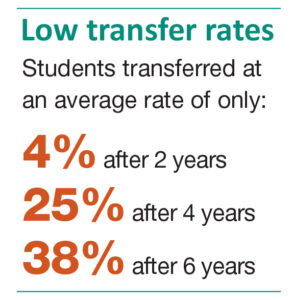Despite recent reforms, transferring from California’s community colleges to one of the state’s public four-year systems is so complex and cumbersome that it’s costing students time and money — and it also can have an effect on the state’s economy, according to a new report.
The study by the Campaign for College Opportunity finds that only 4 percent of students intending to transfer between California Community Colleges and the California State University (CSU) and University of California (UC) systems do so within two years. By six years, only 38 percent of students transfer.
Community college students transferring to UC will take 6.4 years to obtain a bachelor’s degree, while transfers to CSU will take 7 years.
This is bad for students, who take longer to complete their bachelor’s degrees and spend $36,000 to $38,000 more than a student who started at a four-year university, the report said.
“When students are stuck in the transfer maze, state spending rises, tax revenue is lost and spots for new students are unavailable,” it said.
It’s also bad for California’s economy, which needs to fill an expected 1.1 million baccalaureate shortfall by 2030.
“When 70 percent of all college students in California attend a community college, a successful transfer path is key to producing the bachelor’s degrees the state needs and that the majority of students in community college hope to gain,” said Michele Siqueiros, president of the Campaign for College Opportunity.
More work needed
California for the past seven years has been moving the needle in smoothing the transfer process for students, the report said. The state’s Associate Degrees to Transfer (ADTs) program has been especially important. Some 68,000 students have earned ADTs since 2010.
However, the process — even through ADTs — is still confusing. For example, ADTs are not the preferred transfer pathway to the CSU system, and the UC system does not acknowledge the ADT with guaranteed admission, the report said.

Source: The Campaign for College Opportunity, “The Transfer Maze,” September 2017
“Students are forced to piece together an education plan with inconsistent requirements demanded by the different systems, schools and departments,” it said. “The factors contributing to the transfer maze are so difficult for students to navigate that even college counselors have a hard time providing good advice.”
Underrepresented students — who are overwhelmingly the majority of the state’s community college students — are especially affected by the transfer hurdles. Of the 67,000 transfers enrolling in California’s public four-year colleges in fall 2016, only 4,100 Latinos transferred to UC (6 percent) and 20,000 to CSU (30 percent). Only 800 African-Americans transferred to UC (1 percent) and 1,900 to CSU (3 percent), the report said.
The root causes
The study outlines six key factors that are causing transfer problems:
- A broken remedial education system that traps students in non-credit bearing courses
- Campus-level faculty autonomy leading to a lack of curricular alignment with other campuses, often within the same system
- A decentralized higher education system comprising community colleges, CSU and UC that operate as distinctive entities with no mandate for cooperation
- Too many choices in general education with inaccessible information for students to make informed decisions
- State budget cuts and high demand at community colleges means that many campuses do not offer the full range of courses students need or courses are oversubscribed causing delay in the time it takes a student to transfer
- The ratio of community college counselors to students is 615 to 1. The inability to meet with a counselor or meet with the same counselor over time leads to students guiding themselves or receiving inconsistent guidance.
Guided pathways models
Among the report’s recommendations is that the state’s community colleges adopt the guided pathways model.
“Given the complexity of transfer and the myriad options available to them, a guided pathways model provides clearly structured program maps that enable students to plan out a course of study under the close guidance of faculty and advisors,” the report said. “This model simplifies decision-making and allows students to more efficiently meet their goals of transfer.”
Even when students are unsure of their major or even what college they want to attend, the pathways model provides one common exit that can lead toward transfer and completion of a baccalaureate, the report said.

